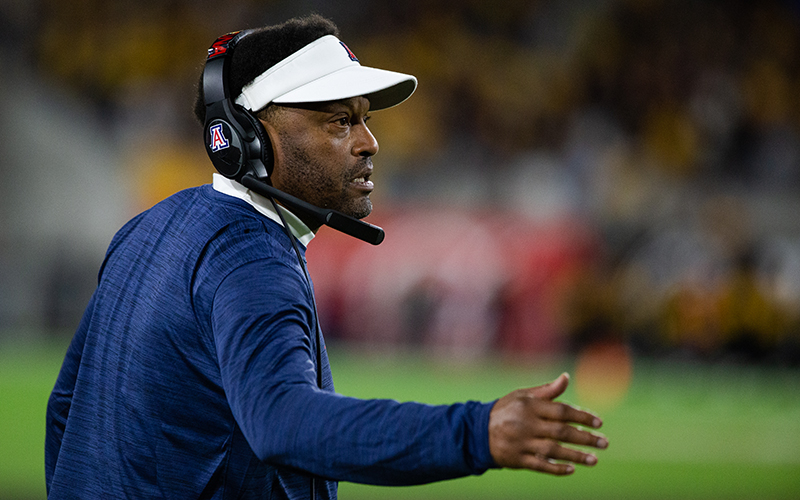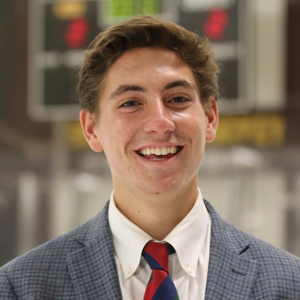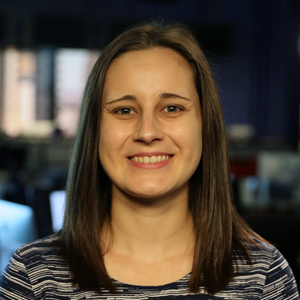
Unlike most Pac-12 Conference coaches, Arizona Wildcats coach Kevin Sumlin was able to hold four spring practices before the novel coronavirus shut down the sports season. (Photo by Sarah Farrell/Cronkite News)
PHOENIX – Although the Pac-12 has suggested an on-time start to the college football season is possible, the conference still must wait to see how the six states where the teams are located are handling the pandemic.
The league said in a statement Tuesday that it will allow voluntary in-person athletic workouts for all sports beginning June 15, “subject to the decision of each individual campus and where permissible by relevant governmental entities.”
The states in the conference – Arizona, California, Oregon, Utah, Colorado and Washington – have moved at different paces while they reopen.
Arizona’s limitations have not been as strict as some other states. Gov. Doug Ducey allowed the state to reopen May 15.
Arizona coach Kevin Sumlin was able to conduct four spring practices, from March 2-6, before spring break.
“I think the big thing has been communication with players and their families, just about where we are in being honest, sometimes being honest about something you don’t know is OK,” Sumlin said during a recent webinar held by the Pac-12.
Sumlin is one of two coaches in the Pac-12 who was able to complete several spring practices. Moving forward, his main concern is the safety of his players, he said.
“Everything we do is not about X’s and O’s, particularly during the last month and a half because lives have been changed, lives have been turned upside down,” he said.
Oregon went into a state of emergency March 8 with a total of 14 cases, and concerns grew as a neighboring state – Washington – became one of the first and hardest hit. Oregon Gov. Kate Brown has designed a three-phase plan for the reopening of the state. A stay at home order was extended to July 6, but some counties have been approved to enter phase one.
The University of Oregon, in Lane County, is one of those in phase one, which requires proper social distancing, with personal care services, restaurants and gyms to open with guidelines.
Ducks coach Mario Cristobal said he has been reminded of how important team camaraderie and chemistry is, as his Zoom calls run late because everyone is enjoying the company.
“You still got to stay fresh as a teacher while you’re doing this via Zoom … so what are you showing, what are you detailing before them to try to advance, try to get better in this game, increase their football IQ,” said Cristoabal, whose team is coming off a 12-2 season, including a win against Wisconsin in the Rose Bowl.
“So they’ve got a bunch of guys that are 15, 20 minutes early and some of the conversations and some of the joking around last year going on was absolutely hysterical.”
California coach Justin Wilcox is in a very different situation. Stett Holbrook, a spokesman for the university, told CNN on May 12 that the Berkeley campus may not fully reopening for the fall semester. Wilcox is ready for any plan that will help get athletes back on the field and has been kept up to date by the university. Recent news isn’t encouraging for the school. In Alameda County, where the Golden Bears play, the number of cases continues to rise.
California was the first to have a statewide stay at home order beginning March 19. The Golden Bears were able to get in four spring practices, which Wilcox said was productive as the momentum carried on throughout the virtual meetings, allowing coaches to learn about the team.
“They’re still able to get to know (players) because there’s a lot of dialogue going on, whether it’s football, or nothing to do with football, which is really important in this whole process,” he said
The conference is still sorting through how to deal with the states’ different paths.
Steve Coughlin, a tight end for Stanford from 1996-99 and a contributor to ESPN’s “SportsCenter” with Scott Van Pelt, believes there should be an even playing field once everything is figured out.
“So I think once we get sound, once we get to it, I think everybody’s going to get like six weeks at camp. I think that makes the most sense,” Coughlin said.
Coughlin believes that training camps should be held in states that are allowed to be open, but he agrees bringing players back on campus is the best sign that things are back to normal.
“Just getting guys back and figuring things out, then I think we’re pretty close to that,” he said, adding, “I’m a lot more optimistic than I was even a week ago.”



